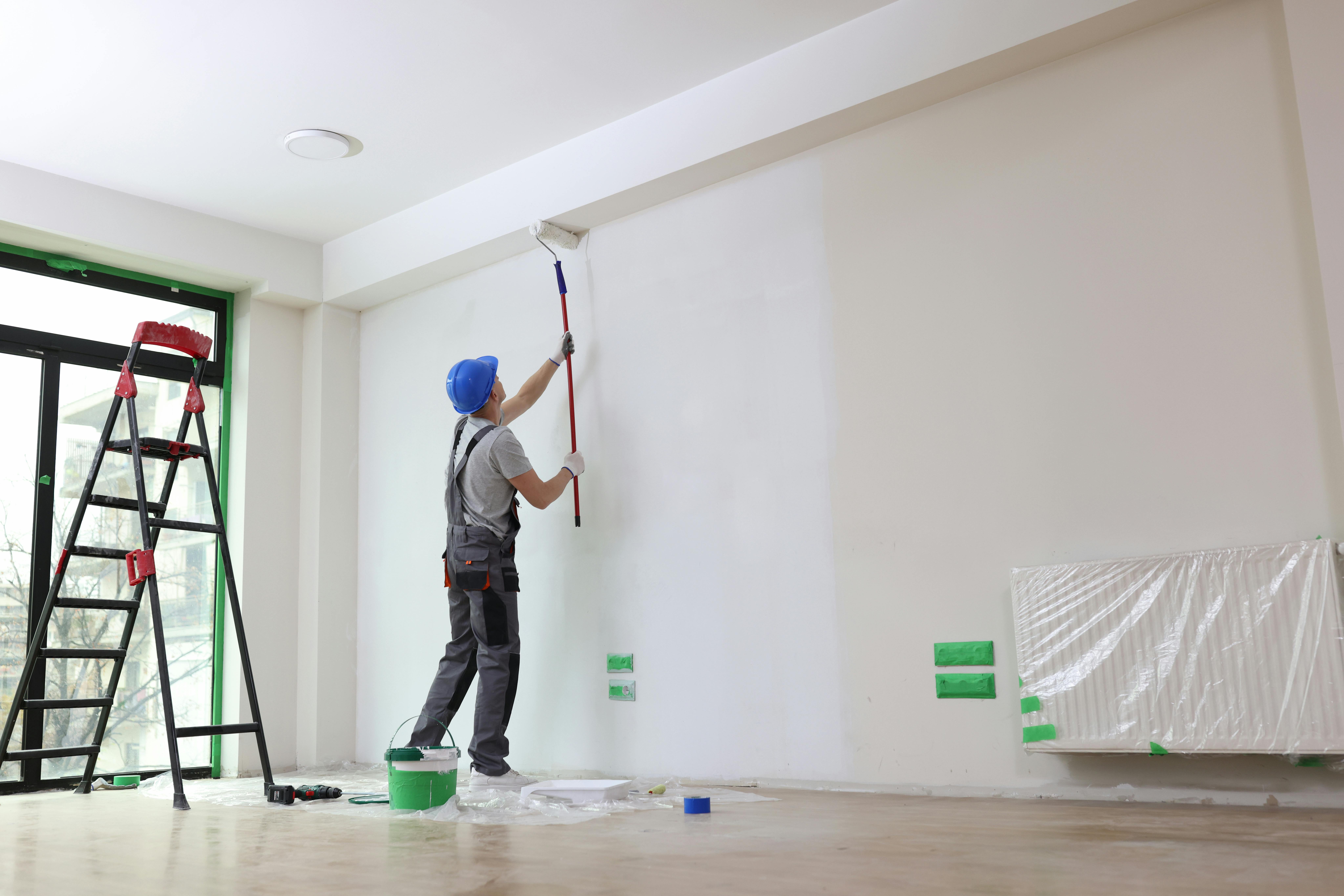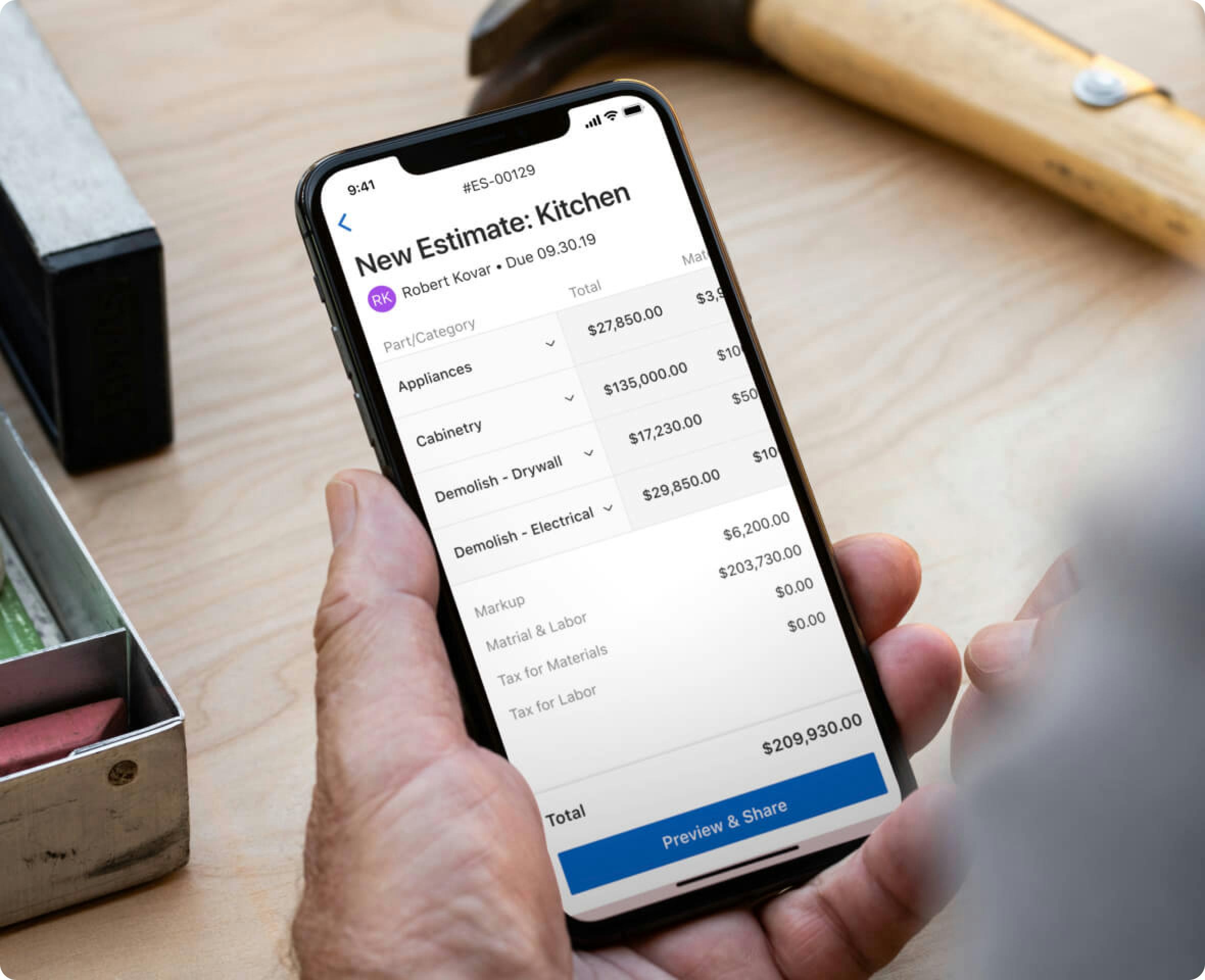Free Template: How to Write An Estimate for a Paint Job
Create professional estimates with our customizable painting estimate template.

Submitting professional and accurate painting estimates is a key part of being a pro in the painting industry. For some, perfecting the skill is one of the most challenging parts of running a painting business. In this article we explore why painting estimates are so important, the elements to include in one, and a step by step guide to get you started. We also include an example, and a free, downloadable painting estimate template that you can edit and customize to meet your specific painting job needs.
As you explore this article, click on a link below to jump to the section you’re most interested in:
- Download our free painting estimate template
- What is a painting estimate?
- Why are painting estimates important?
- When do you send a painting estimate?
- What should be included in a painting estimate?
- How to estimate for interior painting
- How to create a painting estimate step-by-step
- Alternatives to painting estimate templates
- Final tips for writing great estimates
Download our Free Painting Estimate Template

Here's a Painting Estimate Template on Us!
Customize this Painter Estimate Template to secure your next job.
With a long to-do list of the things you need to accomplish to launch your painting business, you probably are seeking to learn more about how professional painters draft estimates that win them jobs.
This free, downloadable painting estimate template will help you begin. It is available in both Word and Excel, and contains a painting estimate example to serve as an inspiration and guide for creating your own. Once you download the template you can print it, email it and share it with potential clients. And, because it is easy to edit the painting estimate template, you can brand your estimate with your company logo and tailor it to meet your circumstances.

A template is an excellent learning tool to get started, but many painting pros quickly opt for the advantages of using a paint estimate software instead. Adopting software that includes paint takeoffs makes running a business more efficient in the long run, and helps painting professionals to deliver estimates more quickly and accurately, ahead of their competitors.

What is a painting job estimate form?
An estimate is an educated best guess of what a painting job will cost. It is used to set expectations for clients and determine if their budget matches up with the painting services they are seeking for you to provide.
It differs from a quote, bid or proposal, all of which are more detailed. An estimate may change and is not legally binding, while a quote is the amount you will charge the client for a painting project. Once signed, the expectation is that the quote will be met. Where you land in the end compared to the quote impacts the profit a painting pro earns.

Why are painting estimate sheets important?
Knowing what a job will cost is crucial for both you and your potential client. It assures that everyone is on the same page, and helps you to know how much you will need to charge to cover your expenses and incorporate a profit to keep your business growing and thriving.
There are several variables that impact the costs calculated in a painting estimate. Here are a few:
- Type of Paint Both the type and brand of paint impacts the price as well as whether the painting is an exterior or interior project.
- Number of Coats As every painter knows, the existing color of the paint on a structure compared to the new color, and the condition of the existing paint and surfaces helps determine how much primer is needed as well as the number of coats required to flawlessly cover the old paint. This, of course, impacts the cost.
- Job Size Naturally the larger the painting surface, the more surfaces and the more varied they are, the more paint and labor that will be needed to complete the job.
- Condition of Structure The extent of prep work can vary greatly depending on the consideration of the outside of the home, or the interior walls. Filling holes, smoothing out surfaces and removing existing paint increases the cost of the project. Pristine, never painted walls will take less time to complete.
- Complexity of the Job Homes with multiple colors, surfaces and design details, such as historic homes, may require a higher level of painting skills, and increase labor costs. Costs for equipment and scaffolding can also increase when projects involve painting multi-story structures, and higher than standard ceilings, and vaulted ones, for example.

When do you send a painting estimate?
A painting estimate is typically the first detailed document you will provide a client to set expectations, timelines and expected costs unless they have specifically requested a formal bid to start off. If successful, an estimate will typically lead to a quote or proposal that is more detailed and one that becomes legally binding when signed by all parties.
An estimate walks the line between a document that is not so specific that it overwhelms your new customer, but is not so sparse that it omits key information that will assure the client that this will be a successful painting project.
An estimate is not the final document before a job begins because it typically but most of the details can be used to create a proposal or quote should the clients want to move forward. A quote provides what you will actually charge for the project and therefore includes all the specifics of the painting project including exact measurements, type and quality of paint, and more. A proposal provides all these details as well as background about your business and past painting projects.

What should be included in a painting contractor estimate template?
Here are some common elements that make up painting cost estimates:
- Company Name, Logo & Contact Information Include your company logo and any other branding to make the estimate uniquely yours. Add your company name and location and the name and contact information of the person from your team who will oversee the painting project.
- Client Name & Contact Information Add the name of the client, name of project and the person who will be the best contact point during the life of the project.
- Estimate Number and Date Keep your estimates organized and easier to find by creating an estimate number and date. Develop an intuitive numbering system to help make the records easy to locate and search for online.
- Labor and Materials Detail the estimated labor and materials that will be needed to complete the project. This may include line items for materials such as paint, primer, scaffolding, equipment, sprayers, caulking and more. Or, you may choose to list the overall cost per square foot for painting including the labor and materials and note the costs of some of the materials. Whatever your approach, this section should make it easy for clients to understand the costs behind their painting project so they understand the value they are receiving.
- Summary of Costs This is a wrap up of all the costs involved in the painting project, and any other major line items.
- Acceptance & Signature Include a section for all parties to sign, date and accept the estimate.

Optional Sections to Include in an Estimate for a Paint Job
Some painting professionals add less crucial details to their estimates in cases where they think more clarity is needed or the information will make their estimate more competitive. Here are some examples:
- Room A more in depth description of how you will transform a room from its current state to a freshly painted one can signal to clients that you understand their vision for the living space. The pro may also point out how they will handle any special features or repairs and patching needed on the surfaces.
- Scope of Work This provides clarity on the extent of the work being performed so that everyone is on the same page, and clients know what is included in the estimate and what is not. This is a good place to note who is responsible for moving any appliances, furniture, artwork and other items in the room.
- Discounts Note any discounts you are offering. This may include special pricing for certain paint products, a discount for new customers or incentives for clients to pay for the project in advance.
- Terms & Conditions It is a good idea to clarify the terms and conditions of the estimate. For example, you may want to note when payments are due, set an expiration date for the prices in the estimate, and set any time limits a client has to inspect the completed work to request any touch ups.
- Additional Notes Add any other crucial information that may be unique to this painting project.

How to Estimate for Interior Painting
With all its complexities and moving parts, fine tuning estimates for indoor work can be more challenging than crafting the perfect exterior paint estimate template. In every room, there are multiple elements: ceilings, trim, moldings, doors, window frames and more. In many cases, clients want an accent wall, and with the popularity of other-than-white ceilings, some clients may want each element painted a different hue.
Here are some tips for creating a reliable interior paint estimate template:
- Measure, Measure, Measure Of course, start by measuring each room and surface to be painted. Because rooms blend together, especially in open concept scenarios, it helps to create a diagram of the areas to assure everyone is on the same page.
- Take it Per Room Tackle one room at a time, coming up with a base estimate. Then, add up the amounts for each room to get your total.
- Account for Special Circumstances In addition to your base rate, consider the extra details in each room, and figure in the extra costs where the work is more detailed or there are more trim elements than normal, or the heights are beyond standard.
- Don’t Forget the Rest Remember to include closets, doors, shelves and other items that make up the room, and decide what your rate will be for those.

How to Write a Painting Estimate Step-by-Step
Now it’s time to get started. Here’s a step-by-step guide for creating a painting estimate:
1. Choose an Estimate Tool Yes, you can start from scratch and type your entire estimate in a document, or even pull out paper and pen. But, why would you? There are many modern, tech tools available to make the whole process easier, and guide you along the way such as templates and estimating software. Decide which tool you want to use to begin.
2. Review Project Plans Do you have enough information about the project to draft the estimate? Go over the scope and plans, and visit the job site or consult further with the clients to get the information you need.
3. Conduct Takeoffs Using a takeoff tool helps you input measurements and automate complex calculations so you can create accurate estimates more quickly.
4. Estimate Material & Labor Costs
- Fixed Costs Figure in the fixed costs of running your painting business. This includes your monthly expenses for office rent, equipment, computers, vehicles and more.
- Variable Costs This is the cost of your labor and materials, and any other costs that vary with each project.
- Profit What percentage profit do you expect and need to keep your painting business growing? Determine this and fold it into your estimate.
- Estimate Painting Labor The more complex the job, the higher skilled labor you will need and the longer it will take to complete a job. Consider the type of job when figuring labor costs by multiplying the number of hours by the labor rate. Research the hourly cost of labor in your region through job sites, competitors, and government websites.
- Estimate Paint Materials Research the wholesale prices of materials in your region and build a strong working relationship with a quality wholesaler. Consider the type of paint and brand clients are seeking as well as all the other materials that will be needed to carry out the project.
- Prep Work Prep work can dramatically change the cost of a job even if the houses are the same size. A house with a large number of windows will be more labor intensive than one with fewer windows and trim. Also, the cost of sanding, patching and stucco repairs varies with the condition of the surfaces. Power washing requires equipment and clarification on who is supplying the water.
- Determine Markup With your labor and material costs calculated, add in your markup for overhead costs and profit to assure that you are covering all your expenses and more.
5. Calculate Total Costs Add everything up to reach the estimate total that you will present to clients.
6. Seek a Review It is always helpful to get a second set of eyes on your estimate to make sure you did not overlook something. Asking a trusted colleague or mentor to review your estimate can help avoid costly mistakes.
7. Preview and Send Ready? Give your estimate one final go over and hit send.
8. Track Feedback or Approvals Now that your estimate is in the hands of your potential clients, make sure you have a way to follow up, gather feedback and track approvals.

Alternatives to Free Painting Estimate Templates
Painting estimate templates are a great way to get started because they serve as a guide for those learning how to draft estimates. But using a painting estimate software instead speeds up the process even more and helps painting professionals run their businesses more efficiently.
Explore how Houzz Pro’s painting contractor business software simplifies and accelerates the necessary task of creating accurate and professional estimates that stand out from the competition. Learn how the all-in-one software lets you more efficiently handle invoices, generate leads and track projects.

Final Tips for Writing Great Painting Estimates
In closing, here are some reminders of other ways to make your painting estimates stand out from the rest:
- Understand Scope Before You Begin Make sure you have a clear idea of everything the painting project entails. This avoids surprises and misunderstandings down the line.
- Think About The Painting Skills Required Not all painting jobs are created equal especially in cases of interiors and exteriors that include many decorative details, multiple stories and a different paint color for every surface.
- Don’t Forget Overhead Operating a business costs money so be sure to account for that in your estimates.
- Account For Related Services Provide clarity on who will be moving furniture, and removing art and other valuables from the rooms. Be sure to figure in costs for any of the services your firm will be responsible for.
- Compare Against Competitors Know what competing painting companies are doing. This can help you check whether your estimates are competitive for your region, its demographics and the demand for painting services.
- Learn From Your Mistakes Estimating is a complex business. No one gets it right every time. By growing from your mistakes, your estimates will get better time after time.
Conclusion
Painting estimates are a necessary part of managing and growing a successful professional painting business. Making them the best in class in the industry takes some effort, but you will be well on your way by following the tips that have worked for other painting pros.
View our painting estimate example or download our free painting job estimate template to get started today. But don’t forget that state of the art tools can help you create professional painting estimates as quickly as clients expect to receive them. Explore our paint estimate software and paint takeoffs with a free trial of Houzz Pro.

Want advice delivered to your inbox?
Unlock industry insights and updates for contractors and design pros
By signing up, I agree to the Houzz Terms of Use and Privacy Policy and that Houzz may use my information to contact me about relevant content, products, and services.







Join the conversation by commenting or asking a question below. The Houzz team reads every single comment, and we’ll get back to you by email if you need us!